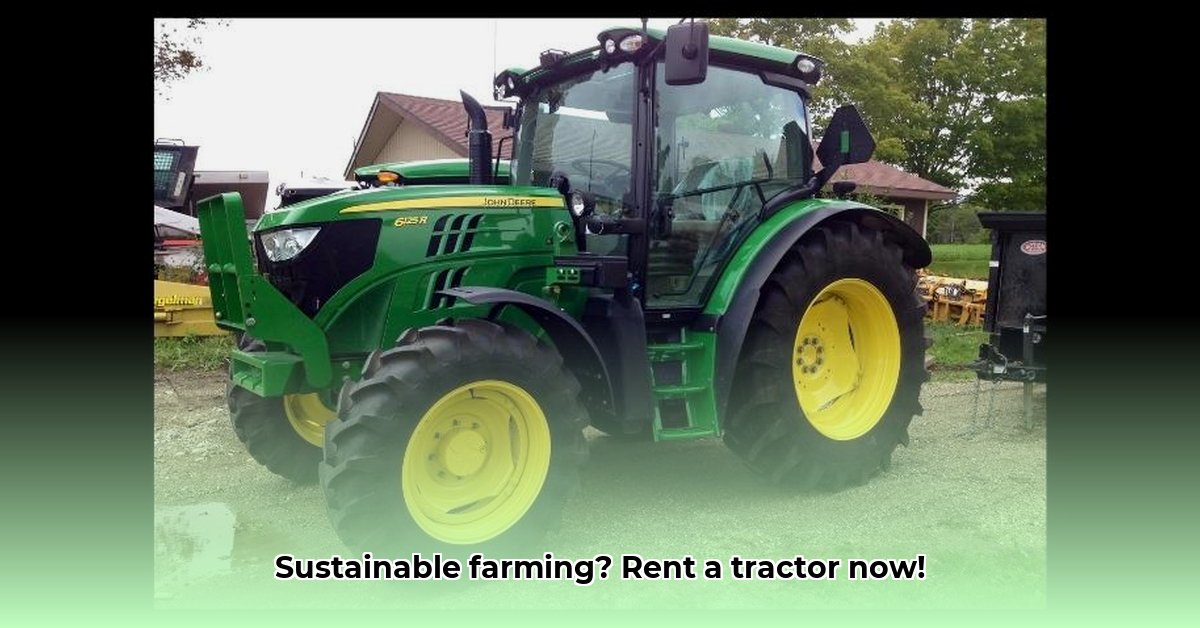
Sustainable farming practices are increasingly important, but the high cost of farm equipment can be a significant barrier. Renting a tractor offers a financially savvy and environmentally conscious solution, allowing you to access the tools you need without a massive upfront investment. This guide provides a step-by-step process to help you find, rent, and operate a tractor effectively, maximizing your yields while minimizing your environmental impact. For more on soil health, check out this helpful resource: soil and garden resources.
Finding the Perfect Tractor for Your Sustainable Farm
Choosing the right tractor is crucial for efficiency and sustainability. Here's a step-by-step guide to help you navigate the process.
Step 1: Assessing Your Farming Needs
Before you even start searching, carefully evaluate your farm's specific requirements. What crops are you growing? How many acres do you need to cultivate? What tasks require a tractor (e.g., plowing, planting, harvesting)? Accurately determining horsepower and size requirements is critical for choosing a suitable tractor and avoiding costly mistakes. Consider the scale of your operation; a small family farm will have vastly different needs than a large-scale commercial operation.
Step 2: Locating Reliable Rental Providers
Several avenues exist for finding tractor rentals. Start by exploring reputable national companies such as Sunbelt Rentals 1, which offer a wide array of agricultural equipment. However, don't overlook local farm equipment dealerships or smaller, independent rental businesses. These smaller providers may offer specialized equipment or more competitive pricing. Remember to compare prices and rental terms meticulously to ensure you secure the best deal. Is it more cost-effective to rent a smaller tractor for several periods, or a larger, more powerful one for a shorter period?
Step 3: Thorough Equipment Inspection
Before signing any rental agreement, perform a comprehensive inspection of the tractor. Check for any signs of wear and tear, rust, or damage. Assess its overall maintenance condition and confirm the presence of all essential safety features. Don't hesitate to ask questions—it's your responsibility to ensure the tractor's suitability and safety. Does the tractor have a reliable maintenance history?
Step 4: Understanding the Rental Agreement
Carefully review the rental agreement before signing. Pay close attention to insurance requirements, liability clauses, and payment schedules. Clarify any ambiguities or uncertainties to avoid disputes later. Who is responsible for maintenance and repairs during the rental period? How is insurance handled in case of accidents or damage?
Sustainable Practices and Tractor Selection
Choosing a tractor with sustainability in mind can significantly reduce your environmental impact and long-term costs.
Fuel Efficiency: Prioritize fuel-efficient tractor models to minimize your carbon footprint and operating expenses. Smaller tractors often offer better fuel economy compared to larger models. How much will fuel efficiency impact your overall costs?
Precision Agriculture Technology: Consider tractors equipped with GPS guidance and other precision farming technologies. These features optimize resource utilization, minimizing waste and maximizing yields. Does precision technology justify the higher rental cost?
Environmental Impact: Research the emissions and environmental impact of different tractor models. Opt for models with lower emissions and the use of less-polluting fuels, if available. What are the long-term environmental consequences of choosing different fuel types?
Operating and Maintaining Your Rented Tractor
Safe and responsible operation is paramount. Familiarize yourself with all controls and safety features before starting the tractor. Regularly inspect the equipment for any potential issues and promptly report any problems to the rental company. This proactive approach minimizes the risk of breakdowns and avoids potential extra charges. How can regular maintenance reduce downtime and unexpected costs?
Case Studies: Real-World Success Stories
Many farmers have successfully used rented tractors to enhance their operations. Sarah Miller, an organic farmer, utilized a rented tractor to plant cover crops, resulting in healthier soil and reduced erosion. John Davis employed a rented high-tech tractor with optimized fertilizer application, significantly reducing fertilizer waste and saving money. These examples illustrate the versatility and benefits of renting tractors for various farming needs. What are some innovative ways to use rented tractors for sustainable farming?
Conclusion: Reap the Rewards of Tractor Rental
Renting a tractor offers a practical and cost-effective approach to accessing essential agricultural equipment, particularly for sustainable farming practices. By carefully assessing your farm's needs, selecting the right tractor, and adhering to safe operating procedures, you can maximize yields while minimizing your environmental impact and financial burden. Remember, careful planning and responsible usage of rented equipment are key to successful and sustainable farming.